
Background Image by permission: Allstair Paterson. Blurred and titled.
Today we’re gonna talk about what you should keep handy in an earthquake survival kit if you live in a place that has earthquakes. You could keep this bag in your car but just make sure you have it where you could get to it if you get more than just some rumblings. This won’t be anything like this kit.
Since 61% of you reading this will be reading this on mobile, here’s a quick list, which will all be explained in the article below in much more detail:
Earthquake survival kit list
- A good backpack/duffel bag
- Electronics
- A flashlight for each person
- A way to charge your phone
- Small car jump starter box
- Small solar panel
- AA battery charger/USB device
- Handheld ham radio
- Solar lantern
- Clothing
- A change of clothes
- Neck Gaiter for each person
- A hat or watch cap for each person
- A pair of heavy gloves like masonry gloves
- Poncho and liner
- Water/Food
- Carry some freaking water!
- Water Filter
- A compact stove and pot
- Survival food (like GORP)
- A P38 can opener
- Aluminum foil
- Basic survival items
- A good knife
- A way to start a fire
- Way to signal (whistle)
- A REAL Emergency blanket
- Emergency Documents
- Detailed map of your town
- Ham radio repeater info for your area
- Copies of ID cards
- Hygiene/Medical items
- Toilet paper
- Liquid soap
- Basic First Aid Kit – this one is a good example but look at how much weight/space you want to allocate.
- Chlotrimazole. Not only is it good for foot fungus, it’s immensely helpful for crotch rot if you find yourself several days in a wet environment, which, as I found in Central America, can make you combat ineffective (or able to walk). It can also be used for some girly-problems.
- Glasses if you need them.
- Medicines you need.
- Sunscreen. Definitely get a small container of sunscreen in case you’re outside for a while.
- Girly stuff. No idea there but you’ll need something.
- Baby wipes and talcum powder
- A couple of tough garbage bags
- Cash
About this earthquake but out kit list
I had the opportunity this week to go out to Hollywood and meet several people. I realized two things while I was there: Hollywood does actually have some pretty cool people, and people in the Los Angeles area drive like dicks.
Among the coolest I met this weekend were Josh Wolf (@joshwolfcomedy), Chelsea Handler (@chelseahandler), and their producers: Bob and Li Anne. Josh has a new talk show coming out soon on CMT that you should check out if your humor’s anything like mine. It’s always a good time with comedians and the producers were just as funny.
While we were talking, the conversation came up about people who’ve had to survive in their car for several days – or even weeks – either being snowed-in or because of something like an earthquake. I figured I’d sit down and write up something about earthquakes, especially since my brother lives in NorCal and the movie San Andreas with Dwayne Johnson (@therock) just came out this weekend.
This post should give you an idea of what you should have handy that you could grab quickly if there’s an earthquake to be able to either make it home or wait for rescue. Let’s assume you’re in a decently-sized city and it’s warm out. Otherwise, it starts getting more complicated. Remember; the best kit in the world is useless if you don’t have it with you when you need it so don’t get all crazy and pack it full of 70 pounds of crap so you end up leaving it at home.
First thing: there is no be-all, end-all solution for the best emergency kit, bug out bag, get home bag, or INCH (I’m Not Coming Home) bag. As with all other kinds of emergency preparedness, you have to analyze the threats you could face, the risks those threats present, your vulnerabilities, and what mitigation strategies you should implement for your most likely circumstances. Also, there are many, many things you could substitute that would be equally as good, if not better.
In other words, you have to think about what’s most likely to happen based on what skills you (don’t) have, where you live and where you drive. There are some basic things you should do that will help in pretty much all situations.
I’m also assuming you’re carrying at least the basics of an EDC kit (Every Day Carry), like a lighter, a knife, and a flashlight. If not, you should start. If you’re not gonna start, throw in a spare in your bag for each of those items, preferably not an identical spare.
One thing you’ll notice is that this bag is heavy on electronics and light on survival gear. That’s because I’m assuming you live in an urban area and won’t be needing to survive away from buildings and other people. Your particular circumstances may completely shift what you need to carry.
Just remember that you may be carrying this bag for several miles so don’t overpack it. Once you get it together, take it out for a walk. Remember this about gear you carry: ounces equal pounds and pounds equal pain.
How to make an emergency earthquake bag:
A good backpack/duffel bag
In this particular situation, you probably don’t want to look too high-speed or military. Try to keep your bag plain and tough, and if at all possible – waterproof. It would also help quite a bit if it were the kind of bag that was both a duffel bag and a backpack, but if I had my druthers, I’d choose a backpack over a duffel bag.
If you end up getting something that looks expensive, you might want to consider beating it up a bit or doing something to make it look less expensive. The last thing you want is for someone to notice your expensive bag and then want all the expensive stuff you have in it. Cover up that Prada logo. You know who you are.
Other than that, it doesn’t much matter about the bag. You should only be carrying it for a few days plus whatever hiking time you take with it to get used to it. There are tons of good options out there.
If you find yourself without a bag, just up what you can find in a blanket or sheet and wrap it with belts, cordage, wires; whatever. Here’s a video to give you an idea:
Electronics
A flashlight for each person
I used to carry flashlights that took CR123A batteries because they’re powerful and I could get batteries from the Army. I’ve now switched over to AA-powered flashlights. AA batteries are everywhere.
This little 7W AA flashlight is pretty freaking awesome. It’s less than $5 and very tough. It’s also like a freaking torch. DEFINITELY get a few of these. You’ll find that you end up getting more and more of them to give as gifts too. If you have a few of the other things listed in this article, this will be more than sufficient and a much better solution than one of these.
There are tons of tactical flashlights that would work well too, for a ton more money. I’d just suggest you stick with AA-powered so you don’t have any problem with power.
A way to charge your phone
If you have an iPhone, you won’t be able to use a generic USB cable to charge your phone (obviously). If your battery jumper box (or equivalent) doesn’t have a cable for your phone, get one and keep it in your bag.
Obviously, a USB cable doesn’t pull in electrons out of the air to shove into your device, so you need something that will. A small USB AC adapter (a good one, not the crappy ones) won’t hurt to carry but you might not have AC available so the next few items will give you a LOT more flexibility.
You should always overlap what you’d need during a critical emergency with things you can use every day or during lesser emergencies – especially things that can serve more than one purpose.
During large-scale or regional events, one of the first things to go out is power. Without power, your cell phone or other communication devices will eventually die. Because cell towers also go down during events like this, your cell may repeatedly try to connect, which will kill your cell battery even quicker.
If the towers are even working at first, you won’t be able to get through because EVERYONE will be trying. If the local power grid isn’t working, those towers will lose emergency power somewhere within a few hours to a couple of days. It doesn’t do you much good to have a cell phone to call for help or find your family if your battery’s dead and you can’t charge it.
If the roadways collapsed and vehicles couldn’t move, just as with what happened as a result of the Loma Prieta, CA earthquake in 1989, you won’t be driving your car anywhere any time soon. That means that you won’t be able to just plug your phone into your 12v plug unless you’re staying with your vehicle, which probably wouldn’t be the case unless it’s a smaller, more local event.
This happened to thousands of people during Katrina and Sandy, and cell phone companies aren’t likely to change any time soon. At least China has started addressing the problem with portable charging stations at relief centers to be used after earthquakes but I wouldn’t expect to find anything like that any time soon.
Once some semblance of security and immediate medical care is established, some forward-thinkers will have generators running, which will mean lines of people trying to use it, just like they did after Hurricane Sandy and every other major US disaster (or steal it in the middle of the night).
Once you’ve pulled all your equipment together, eliminate any cables or accessories that you don’t need or that are duplicates.
Small car jump starter box
One great little device to have is a small jumper box.
I hear ya out there in your underwear saying ‘WTF? Why would I want to carry something to jump cars?‘
Jumper boxes used to be huge, heavy things you only threw in your car to help someone out who needed a jump. They’re now down to about the size of a USB hard drive and can charge your cell phone or even your laptop in most cases. You do have to balance the weight/space with the benefits but because they’re now about a pound or less, I say carry one.
These things are pretty damn awesome. If you have a medium-sized car and larger, look at something like this one. It has a 16,000mAh battery, which is pretty powerful for these things. If you have a motorcycle or small car, you can go with something less.
A kit like this will also allow you to charge the jump starter using either generated power you come across or batteries from abandoned cars (which would be WAY too heavy for you to lug around with you instead.
Small solar panel
For me, if I find myself in a large-scale earthquake across Los Angeles, I’d rather not have to rely finding a line to stand in to charge my battery, or an abandoned car to break into to get to the battery – especially since the security situation may not be conducive to roaming the streets for such things. Solar panel technology is now to the point where you can easily pack a collapsible solar panel that you can lay out on the ground or on the roof to charge your stuff.
Keep in mind that you’ll want to also have some kind of either USB battery, or preferably a car jump starter as mentioned above, so you can charge that instead of directly charging your electronics. Some things like iPhones will cut off charging if a cloud or shadow comes over and not kick back on unless you either reconnect the solar panel or have really bright, direct sunlight to kick it back on. The battery won’t care if it’s getting a lot or a little current and can then be used to charge several devices later on, even at night.
Luckily for me, P3 Solar sent me out a Dynamo Plus for my upcoming Harley/camping/novel-writing road trip across the U.S. It has the jump starter box as well as a folding 12v solar panel that fits in my rear pack document folder thingy. They also sent me out a charge controller, which allows me to charge my motorcycle battery directly from the solar panel. I’ll let you know how it all works out but it’s pretty handy so far.
AA battery charger/USB device
If you switch to having only flashlights and other things that take batteries to ones that only use AA, it makes things TONS easier. A little device like this Goal Zero Guide 10 Plus will allow you to charge rechargeable AA batteries with the output from a solar panel or portable battery. This means that as long as you don’t lose your batteries, you should never run out of light.
The other thing this handy little device does is allow you to use the power you’ve stored in your rechargeable batteries (or any other charged AA’s that you come across) to charge your USB devices. It’s like a mini USB battery (just with less total power available). It also has a built-in backup flashlight.
Solar lantern
This one is not a necessity but it does make things more comfortable.
I searched long and hard for some kind of useable portable lantern solution. Flashlights are extremely useful but they’re not so good for covering an area like a room or picnic bench-sized area.
MPOWERD has a great little thing that’s absolutely PERFECT for this. It’s called the Luci Lantern. It collapses to about the size of a CD case, is waterproof, and charges by just laying it out in the sun. It lasts for quite a while and throws off plenty of light for a small area.
It’s WELL worth the $15 or so. So much so that I’ve gotten a few of them now and all my neighbors got some and gave them out as gifts this past Christmas.
Handheld ham radio
After a large earthquake, you can be pretty sure you won’t be able to use your cell phone, at least any time soon. The best emergency communications solution, by far, is actually a ham radio.
I personally carry a Yaesu VX-6R with an upgraded Diamond SRH77CA antenna. There are certainly other radios you can use but this one can handle being out in a rainstorm or dropped in the water. Pretty much any radio you get is going to need an upgraded antenna because the stock ones suck.
To be able to charge the radio with either my jump starter battery or a vehicle (or my solar panel with the 12v plug adapter if I really needed to), I got the additional Yaesu 12v DC charger. I don’t have to worry about having a dead ham radio.
A radio like this will not only allow you to communicate with others (provided you have a license, which isn’t too hard to get anymore), you can also listen to emergency channels and weather channels so you know what’s going on.
Now every time I mention something about ham radios, some idiot wants to sound all experty and says that you don’t need a ham radio license during an emergency.
No shit, Sherlock.
Ham radios aren’t very user-friendly, however. If you’re expecting to pull one out and use it for the first time during an emergency, you’re probably not gonna get through to anyone any time soon.
You NEED a license to transmit now so you can learn how to use them when the time comes. You’re gonna feel like an idiot if your friend is bleeding out while you try to figure out how to adjust your offset freqs to hit the repeater so you can call in for rescue.
If you don’t want to spend a lot of money, Baofeng has a few really inexpensive ones that would work in a pinch. They’re MUCH less expensive but they’re harder to figure out and require an adapter to connect a better antenna. They also don’t have a convenient 12v charger system for some reason. I still have one though since they work and they’re so cheap.
Clothing items
A change of clothes
At least carry some socks. Battles have been lost because Soldiers didn’t take care of their feet.
If you have room, carry a spare pair of pants that aren’t cotton. Cotton doesn’t dry well and will suck the heat right out of you when they’re wet.
If you wear high heels or anything that you wouldn’t be able to walk in for a few miles, you may need to toss in something else.
Neck Gaiter for each person
One of the best things I discovered was when I was issued a neck gaiter from the Army. Holy crap are these things pretty awesome. You can make them out of old sweatpants legs if you really want to but they make several different types. They all pack extremely small and are hard to beat how much warmer they can keep you for the weight/space/cost.
They work by fitting on your throat/neck area to keep the heat from escaping the inside of your shirt/jacket. You can get thick ones if you’re expecting it to be cold or thin ones for chilly weather. They can also be used as a hat. I keep one on my motorcycle along with a pair of swimming googles in case I get caught in a haboob.
Phoenix Haboob | September 6th, 2014 from Mike Olbinski on Vimeo.
Poncho and liner
A good poncho can be a lifesaver if you’re stuck outside overnight, which is why we got them in the Army. It can be worn to keep you dry in the rain or stretched out as a shelter or a blanket. It’s also useful just to keep all your stuff organized if you want to dump it out on the ground. Go to a surplus store and get a poncho if you can. There are many on Amazon or ebay like this one that would still work but they’re not quite as good.
One of my favorite things, and something that many Soldiers still own and speak quite fondly of if they’ve ever been deployed, is a poncho liner. We call it a woobie. Definitely get a woobie.
A hat for each person
A hat can help keep you a lot warmer if you find yourself sleeping without heat during a cold night. Contrary to popular belief, you don’t actually lose 80% from the top of your head, but you do lose a lot. I carry one of the fleece watch caps I was issued because it packs small, keeps my head toasty, and looks hella sexy. Not as sexy as my awesome outback hat I wear everywhere, but just the right amount of sexy for this kind of situation.
You may be able to skip the hat if it’s warm at night. Just make sure you have sunscreen for your ears and the back of your neck. My outback hat covers all that for me.
A pair of heavy gloves
You’d be amazed at just how quickly your fingers will give out if you’re not used to moving cement and rock all day. After an earthquake, you may find yourself needing to do just that. Gloves can also (obviously) keep your hands warm on a chilly night.
Get a good pair of heavy-duty gloves so you can move what you need to and also give yourself some added protection against being cut or stabbed by sharp objects. Masonry gloves would be what I’d carry if I lived where earthquakes roam.
Food/water
Carry some freaking water!
One thing you have to have in your car at all times is water. Just do it. You can only go a couple days without water and things get pretty uncomfortable way before that point. I just throw in a case of bottled water in the trunk and leave it there. Take a few bottles out and put in your bag.
Don’t believe the hype going on about how dangerous it is to leave water in your car. I haven’t seen any reputable study that’s actually concluded this is true. If it were really a danger, it’d be pretty easy to prove. The likelihood that you’d die of dehydration because you decided not to carry it is MUCH higher. If you’re really all that concerned with it, then just bring a couple gallons and refill them every few days.
In case you do run out of water you’ve carried, you should have some kind of water filter as a backup. I always carry a Sawyer MINI in each vehicle and in my bug out bag. They’re very compact, filter very well, and with the backflush plunger, can filter 10’s of thousands of gallons of water.
Water Filter
Because you can’t possibly carry enough water with you to survive a week (each gallon is over 8 pounds and you’d optimally need 2 quarts to a gallon a day), you’ll need to replenish your water supply with what you can find. Earthquakes can taint the water in the area so ALL of it that’s not in sealed containers is now suspect. Something like the Sawyer Mini is a very compact and effective solutions, which is why I keep one in each vehicle and each pack I carry. There are chemicals and other dangers that it can’t help you with but it’s a good balance.
With the Mini, you can either drink out of the included collapsible bag or use the included straw. You can also get an adapter kit to put inline with some other kind of water system like a Camelbak.
The other nice thing about the Mini is that it has a backflush plunger that will allow you to keep using the same filter for 10’s of thousands of gallons, which is WAY more than pretty much anything out there.
If you have the ability, you should also boil any water that’s suspect.
Compact stove and pot
With a compact stove and pot, you can boil water to either make it safe or to use in emergency food pouches. You can also use it to stay warm.
I personally have a Solo Stove that’s a pretty cool mini gasifier wood stove. I replaced the pot with a titanium model because it’s tougher and lighter. This allows me to cook with twigs, pinecones, paper, or whatever else like that is around.
Another great solution is to go even smaller and lighter and use a collapsible wood stove like the Emberlit Titanium stove. It’s about 5 and a half ounces, super tough, and takes up almost no space. You can get the steel version for less but not only is it a little heavier, it’s not as strong. It’s still a good choice though. I have the titanium model. I lose some efficiency over the solo stove because it’s not a gasifier but it saves weight and space, so it’s now my primary portable wood stove.
Because there isn’t always something like twigs around to burn, and because I’m just plain lazy sometimes, I also carry a trangia alcohol stove. It fits down inside the solo stove, which not only makes it easy to carry, it makes it more efficient when using it.
The most efficient fuel I’ve found for it is Yellow Heet. I carry the fuel in a 12 ounce Pepsi bottle so it doesn’t spill. The only problem with using yellow heet is that you can’t burn something like that in your car due to the fumes.
I’d suggest carrying Everclear grain alcohol instead. The fumes are a LOT safer and can be used to clean wounds, etc. Theoretically, you can drink it but I’d rather drink pee. Ok, maybe that’s an exaggeration but you know what I mean. Kind of. Also, it can be used to help clean wounds. Everclear, that is; not pee. Don’t use pee to clean your wounds.
Aluminum foil
A few feet of aluminum foil, folded up nicely, can be great for cooking things. You can also use it to fit an AAA battery into an AA slot or as a fire starter with an AA battery and some of your toilet paper.
A can opener
I was motocamping up in Flagstaff for a while a couple weeks ago and these two other motorcycles pulled up next to me. The girl (gorgeous, btw), was just learning to camp and apparently so was the guy showing her. He brought a can of beans but didn’t have a can opener. That’s pretty much a dating faux pas, especially when the guy in the next site is eating steak and corn on the cob, sipping on vodka with a Guinness chaser and has everything necessary for a comfortable weekend, even in the woods.
The easiest can opener to carry would be the old military standby: a P38 can opener (also called a John Wayne by some of my friends). The example link I gave you there also has a P51 can opener. They’re so small you can carry them on a necklace or on a keyring. They’re named from the number of punctures they make around the cans they open (obviously the P-51 was designed for large cans).
Here’s a video in case you’ve never seen one:
Oh, for the camping trip, I had them open the can with a spoon. Simple trick you can use in a pinch but it takes a while. DON’T do that hokey thing where you scrape it on a flat rock or you’ll get stuff everywhere. Here’s how to open a can with a spoon:
Survival food
There are tons of options in the way of dehydrated food that you could carry. They pretty much all taste like crap. I actually like some of the MRE meals better than the emergency food I’ve tried.
A better option would be to carry some homemade (or at least store-bought) trail mix – sometimes called GORP. Pound-for-pound, it’s pretty hard to beat and very easy to pack. You could technically go a week without eating and not die, but not only would that be pretty miserable, you’d lose motivation to do things and your thinking won’t be as clear.
Basic survival items
A way to start a fire
If I could only bring one way to start a fire, it’d be a cheap lighter. They’ll work in most cases. Since you’re in an urban environment, it shouldn’t be too hard to come up with a way to build a fire but you’ll have to light it.
I personally carry a Doan Magnesium fire starter as well. Don’t get a cheap knockoff – get the real Doan one. Here’s why:
A good knife
If I only had one thing I could take with me to survive, it would be a good knife. Once you learn how, you can make shelter, fire, fishing/trapping/hunting equipment, protect yourself, or whittle toothpicks with a good knife.
Unfortunately, some of you live in places where you can’t carry a good knife. Move.
Unless I’m mistaken (I’m not a Calfornia cop so you’ll have to check your local ordinances), you should be able to carry a non-switchblade knife in your pocket or bag.
If you carry a fixed-blade knife, they’ve decided for you that you can’t wear it unless you wear it out in the open. Apparently, according to this finding in 2013, it IS acceptable to carry a fixed-blade knife in your backpack.
I’m not gonna babysit you. Understand your laws. Also understand your right against unreasonable search. Just sayin’.
I personally carry the SOG Seal Pup fixed-blade knife in my pack. It’s the more portable version of the SOG Seal I carried in Africa, Iraq, and Afghanistan. I also carry an Ontario Knives Model II folder in my pocket that I use at least once a day if I’m wearing dress pants or my Gerber 06 S30V tactical that I was issued in Afghanistan for normal pants.
If you don’t already have a multitool in your EDC kit, I’d throw one of those in the bag as well. They can come in handy for lots of things. They do add a bit of weight for how small they are though so you’ll have to balance whether it’s worth the extra weight. Someone in your group should have one though, and you may not be with your group.
An emergency whistle
A whistle is not only a LOT louder than you can yell, it requires much less effort so you can do it for much longer. Just keep whistling 3 times every so often as a distress signal if you’re lost or buried. Get a loud, compact one like this. You may need to plug your ears with something as you blow, and then take them out to listen.
A REAL Emergency blanket
Here’s where I’m gonna probably piss a few people off. That little silver mylar emergency “blanket” you have: it’s shit. Just get rid of it. It’s only good as a heat reflector or maybe something to keep off a light rain but they’ll rip the first time you use them.
Instead, get a real emergency blanket. I have this one in my bag or behind the passenger seat of my Harley at all times. It’s durable, large enough to be used as a REAL blanket, and has both a reflective side and a colored side. I got orange. It’s cool.
Emergency Documents
Detailed map of your town
Unless you live in a small town and never leave, you may have to walk several miles to get where you need to go. I’ve done enough foot surveillance to know that things on foot look completely different than things in a car. 10x different at night. Put a map in your bag that shows friendly “go-to” areas such as police stations, hospitals, and the homes of friends.
One of the things you and your family/friends should also work out in advance is a couple of rally points. In most cases, you’d want to head home but that may not make sense if your work is pretty far. Also, your home may not be accessible during or after an earthquake. Find a couple of options and mark them on your map.
Either seal the map in laminate or put it in some kind of waterproof container that can get banged around a bit without breaking. If you laminate it, make sure you don’t keep folding and unfolding it. Laminate doesn’t always hold up to that after a while.
A GPS is even better if you have it and it works but make sure you have a cable that you can charge it or it’ll be dead weight. I highly doubt you’d have an extra GPS that you could toss in the bag but grab the one out of your car if you can. A paper map doesn’t need electricity; you just need enough light to see it.
List of emergency info
In addition to the map, write down the addresses and phone numbers of emergency contacts and friends you have in town. Also list the addresses of go-to areas that are likely to be on your route or near work/home etc. During an emergency, sometimes all you need is one friendly contact to make a huge difference.
As mentioned above, try to locate each address and mark it on your map so you can find them easier. The easiest way is to put a letter/number on the map (P1, P2, H1, H2, F1, F2, etc) and list them out with that same identification. It’s best if you actually go to the locations but obviously that may be a bit much. At least use google maps and see what’s in the area.
Ham radio repeater info

Get this book to learn how repeaters work. It’s written for beginners.
It’s obviously nice to have them programmed into your radio but keep a written backup as well. There are many places on the internet to start your search but the Amateur Radio Repeater database is a good place to start.
If you’ve made an emergency communications plan with your family, you’ll want to have that info listed as well. You won’t be able to transmit on all frequencies, all hours of the day, so you’d want to have a few different frequencies that you’d transmit/listen on at least once per day.
Copies of ID cards
Make a copy of all your identification cards in case you lose one of them. You may run into a situation where people are asking for ID in order to get back into your neighborhood, for instance.
Medical/Hygiene
Toilet paper
If you have the room, throw in some toilet paper into your bag and make sure it’s in something that will keep it dry. Not only can it double as very good tinder to help get a fire started, you’re a rockstar if you bring toilet paper. Chicks dig toilet paper.
Liquid soap
Staying clean isn’t just being a polite citizen. Clean can help keep you from getting sick.
If you get a cut or scrape, don’t go reaching right away for that antibiotic. Just clean it with some soap and water and bandage it to keep it from bleeding everywhere and from getting dirty. Liquid soap is a lot easier to use than a bar of soap.
Baby wipes and talcum powder
If you’ve ever been deployed, or even just camping, you know just how awesome it is to have baby wipes with you to take what we call a whore’s bath and then talcum powder for your feet and your nether region.
A couple of tough garbage bags
You never know what you’re gonna face until you face it but garbage bags can help you keep things dry in a rainstorm that you hadn’t planned on or keep things organized if you have more things than you can fit into your backpack. They don’t take up much room and are super cheap so you’d might as well just throw a couple in there.
Medical items
If you have anything that might become a problem, see what your doctor recommends you carry with you because they might be able to give you something or some better ideas.
Here’s just an example list of some medical-related things you might have:
- Basic First Aid Kit – this one is a good example but look at how much weight/space you want to allocate.
- Chlotrimazole. Not only is it good for foot fungus, it’s immensely helpful for crotch rot if you find yourself several days in a wet environment, which, as I found in Central America, can make you combat ineffective (or able to walk). It can also be used for some girly-problems.
- Glasses. If you need glasses to see, carry a spare pair in your bag. Walking through the aftermath of an earthquake can present a lot of mechanical injury or cut dangers and your glasses may break at some point.
- Medicines you need. If you have medicine that you absolutely have to take, see if you can keep a week’s-worth in your bag. If you or anyone close to you has a serious allergy that may present a problem (like bees), try to carry an epipen and some antihistamine. Antihistamine won’t stop a severe reaction but it may buy you some time and will help with more minor symptoms.
- Sunscreen. Definitely get a small container of sunscreen in case you’re outside for a while.
- Girly stuff. No idea there but you’ll need something.
Cash
In the immediate aftermath of a devastating quake, things will go back to a kind of barter system for a while so prices and values will be whatever the market will bear, and skills can sometimes be more valuable than stuff. Keep that in mind if you need something from someone and you know something they don’t.
The other thing is that credit cards and ATM machines probably won’t work. It’s not the end of the world so most people will realize that they can sell an extra can of chili (maybe for $20) and use that cash next week or soon thereafter.
Bring some small denomination bills with you. Just don’t flash it around, and don’t keep it all in one place. If someone decides to gank your cash, you don’t want them to get all of it.
Conclusion and miscellaneous ramblings:
As you can see, the list of things to carry in a bug out bag or get home bag in case of an earthquake is pretty similar to most other bags. There are tons of other things you could pack that I didn’t mention, such as paracord. I personally carry 750 cord in my pack (because it’s stronger and has more internal strings), but I think there’s enough cordage in a city from wires, belts, shoestrings, and tons of other things that it’s not as necessary. If you have the room and want to add a few more ounces, go at it. Just remember there are 100 other things that you could do the same thing with. It’s all about opportunity cost.
After you have everything you think you need, put it on your back and actually carry it for a while. Take it for a hike or six. Then go back through and see what you REALLY need. If it’s a nicety or really useful (and you already have it) but you won’t be able to carry it all for miles, take those things out and put them in your car. You may still be able to use them then but you won’t have to start throwing things out on the side of the road because you can’t carry that much weight.
Unfortunately, if you live in CA, you’re not allowed to carry a gun to protect yourself against the thugs you might come across who are carrying guns they aren’t allowed to carry or anyone bigger or anyone who outnumbers you. That’s a big reason I don’t live in CA and why I didn’t go into it in this post. You’ll have to figure that out on your own.
So what would you carry in an emergency earthquake survival bag?
For those of you who Pinterest, here’s a better image to share:
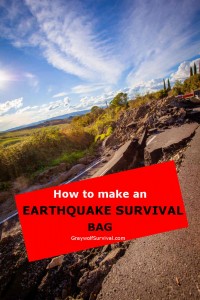

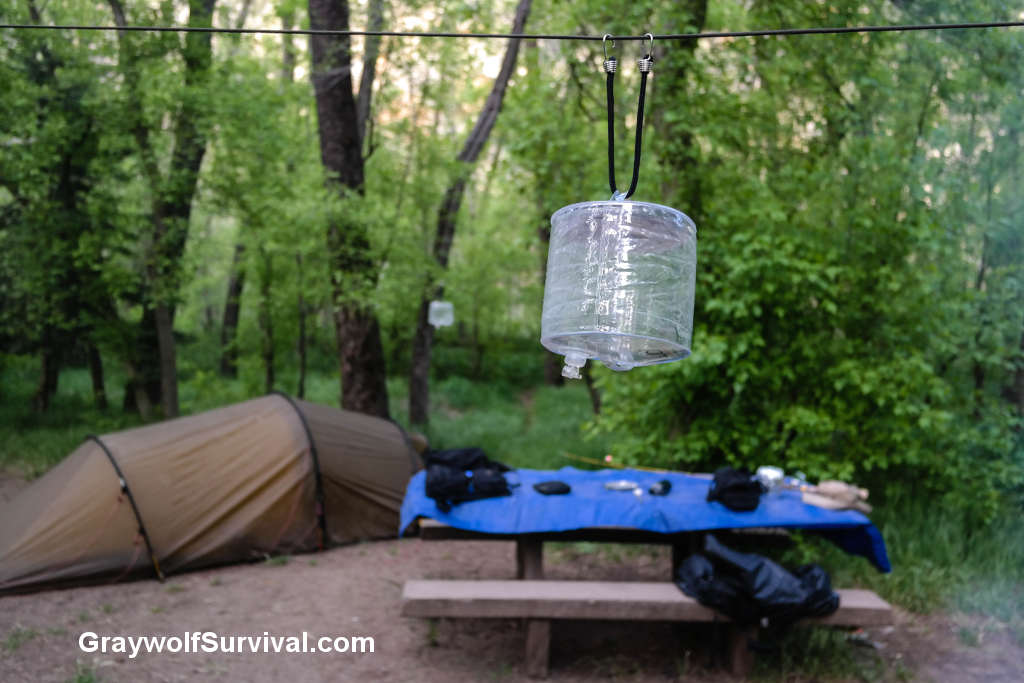
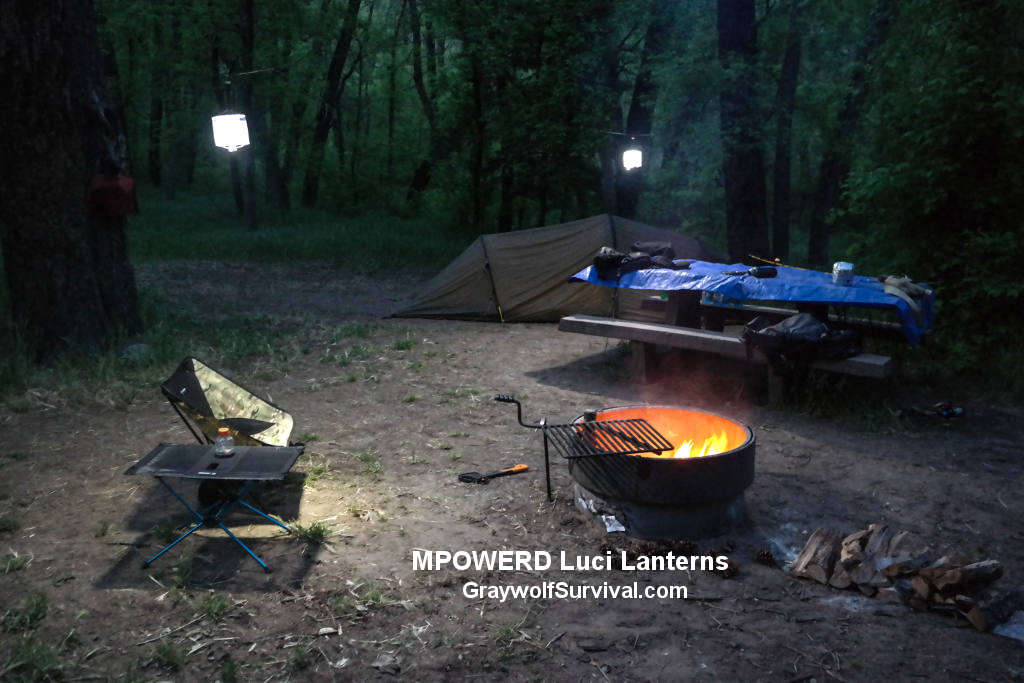
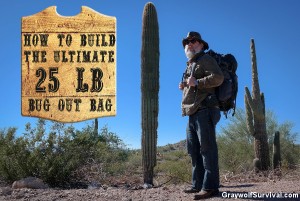


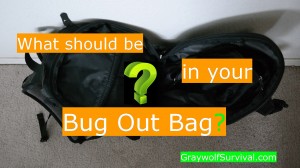

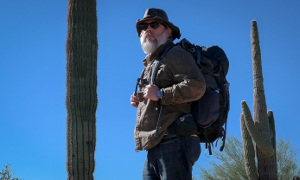
Wow what a list! I think people who live in Earthquake prone areas should evaluate what is necessary for them to get home and from where you are getting home from and the time of the year. In the summer a flashlight for me would be a waste since we have 16 or more hours of daylight. But bug spray (Cutters) would be a life saver. A poncho and military poncho liner could be a life saver also. As for electronics I might be old fashioned but I and many others here favor CB radios. Water, with many streams and lakes a good water filter for me would do. What I didn’t see on the list is protection. With the gangs in almost every large city or town what’s yours is theirs and some gangs will have no problems killing you for what you have. I don’t live in communistfornia and never will so I have my everyday carry in a caliber that is very common. I will help those that I can to the ability that I have and will send to hell those that in a crisis try to steal or take other advantages on the weak. Fire making, I have several “Coghlans” magnesium Fire Starter. When I attended Arctic Survival School at Eilson A F B we had one minute in 10 below zero weather to use flint and steel to build a fire. As with anything learn how to use it before you have to. I could go on but as with any of these expert blogs adjust for your needs and desires after all one man’s opinion is just that his opinion.
For me here where I live if I were within the city limits my survival items will be much different than if I were in Seward or Homer fishing.
You should really check into ham radios instead of CB. They’re FAR superior. You can literally talk around the world with little power if you get your license high enough to use those frequencies. All cities, counties, and states use ham radio for emergency communication and practice with them during large scale practice events. No one uses CB for that. Only exceptions I’ve seen are a few people in Alaska but that’s because they only had to talk to their neighbors who happened to only have CB.
We live about 20 miles west of the New Madrid Fault. I expect to lose the house and would like to site some caches in the hills of the farm. The problem with this is, where the hell can I put them with any reasonable hope they won’t be buried too? Depending on whose disaster map you look at we’ll either be underwater or have ocean-front property when all’s said and done. And I hate fish. Oh well.
You did a great job in letting people know what to do before an earthquake hits. This would also work during other types of disasters like when you get stuck in a place because of floods or storms. Just modify the items on your list. I use an icom v85 ham radio. Yep, it is kinda old but hey, in case of power loss, you can attach it to your 12.5V car battery If you know what you’re doing.
Great insights and information, thank you for sharing. If you have any other recommendations or disaster prep advice kindly email me, I signed up to get be on your mailing list!
While the $5.00 flashlights are probably throw aways, if you have a flashlight with a replaceable, you may want to invest in a few spare bulbs. I was looking proudly at my billy club / Mag Lite and my store of spare batteries in various locations and realized that if the bulb goes the rest is not much good.
“Girly Stuff”? Come on. You can do better than that. I know you’re not scared of blood…
But seriously, you’ve been an incredibly thoughtful resource for helping people be more self-sufficient and prepared for anything and it doesn’t make sense to dismiss the needs of half the population while also letting them know they are neither valued, nor included in your world vision. You expect women to be able to be able to do everything you would expect of yourself, right? (Hunting, self defense, survival skills etc.) So why not address their needs? I’ve seen you do a calorie/cost/protein/weight analysis of various nuts and seeds vs. energy bars, so why not give blood absorption techniques a similar treatment? Or at least the respect of judgement free language. “Menstrual supplies” would’ve been just fine.
Would you recommend a taser for people who don’t / wouldn’t carry a gun? And do you have a specific taser recommendation?
Never looked into tasers myself but someone else may want to chime in. Just be careful of the laws in your area.
Maybe OC spray instead of a taser.
As for guns in those states you can carry one, I’d take a .22. Its ammo is light weight and small, so you can easily take a few hundred rounds with you. A Ruger 10-22 takedown model, or a Ruger Mark 3 pistol are splendid for hunting and self-defense.
To Oldalaskan:
There’s absolutely no need to disrespect California as you call it, “communistfornia”. This is the kind of attitude that separates & divides us. I come from Texas & I now live in the Golden State. It’s full of fine people with great attitudes who help others in times of crisis.
We help everybody, no matter where they live. I survived the 1989 earthquake here just fine. We all pulled together without any disrespect toward each other. I hope that you would do the same. We are the United States of America and we salute the same flag. And, BTW – we are not communists & never have been.